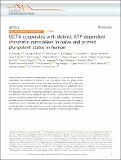OCT4 cooperates with distinct ATP-dependent chromatin remodelers in naïve and primed pluripotent states in human
Author(s)
Huang, Xin; Park, Kyoung-mi; Gontarz, Paul; Zhang, Bo; Pan, Joshua; McKenzie, Zachary; Fischer, Laura A; Dong, Chen; Dietmann, Sabine; Xing, Xiaoyun; Shliaha, Pavel V; Yang, Jihong; Li, Dan; Ding, Junjun; Lungjangwa, Tenzin; Mitalipova, Maya; Khan, Shafqat A; Imsoonthornruksa, Sumeth; Jensen, Nick; Wang, Ting; Kadoch, Cigall; Jaenisch, Rudolf; Wang, Jianlong; Theunissen, Thorold W; ... Show more Show less
DownloadPublished version (6.324Mb)
Publisher with Creative Commons License
Publisher with Creative Commons License
Creative Commons Attribution
Terms of use
Metadata
Show full item recordAbstract
<jats:title>Abstract</jats:title><jats:p>Understanding the molecular underpinnings of pluripotency is a prerequisite for optimal maintenance and application of embryonic stem cells (ESCs). While the protein-protein interactions of core pluripotency factors have been identified in mouse ESCs, their interactome in human ESCs (hESCs) has not to date been explored. Here we mapped the OCT4 interactomes in naïve and primed hESCs, revealing extensive connections to mammalian ATP-dependent nucleosome remodeling complexes. In naïve hESCs, OCT4 is associated with both BRG1 and BRM, the two paralog ATPases of the BAF complex. Genome-wide location analyses and genetic studies reveal that these two enzymes cooperate in a functionally redundant manner in the transcriptional regulation of blastocyst-specific genes. In contrast, in primed hESCs, OCT4 cooperates with BRG1 and SOX2 to promote chromatin accessibility at ectodermal genes. This work reveals how a common transcription factor utilizes differential BAF complexes to control distinct transcriptional programs in naïve and primed hESCs.</jats:p>
Date issued
2021Department
Massachusetts Institute of Technology. Department of BiologyJournal
Nature Communications
Publisher
Springer Science and Business Media LLC
Citation
Huang, Xin, Park, Kyoung-mi, Gontarz, Paul, Zhang, Bo, Pan, Joshua et al. 2021. "OCT4 cooperates with distinct ATP-dependent chromatin remodelers in naïve and primed pluripotent states in human." Nature Communications, 12 (1).
Version: Final published version